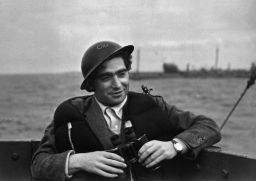Story highlights
Robert Capa was widely considered to be the best photographer of World War II
Capa spent a few days photographing the Battle of the Bulge in late December 1944
Capa had a few close calls while photographing the battle
The U.S. Army calls World War II’s Battle of the Bulge, a six-week campaign in the Ardennes Forest of Belgium that began on December 16, 1944, “arguably the greatest battle in American military history.”
British Prime Minister Winston Churchill concurred, calling it “undoubtedly the greatest American battle of the war.”
So it was entirely appropriate the man widely considered the world’s best war photographer, Robert Capa, was embedded with U.S. troops during a portion of the battle.
Capa’s photos in the accompanying gallery were taken in just a short time at the end of December 1944, according to Cynthia Young, curator of the International Center for Photography’s Capa Archive.
Young said while Capa drew acclaim for his action photos, those he took at the Battle of the Bulge are of a different nature.
“The images of dead soldiers, a farmer burying a dead horse in the snow and German prisoners corralled with their hands raised attest to the bleakness of this deadly campaign,” Young said.
Capa, who Young describes as “decidedly anti-fascist,” was not an impartial observer of the war, but rather an official Allied photographer.

“He photographed for the American and English press to inform readers of the war in the hope that his photographs would help garner Allied support,” Young said.
You’ll see several photos of German prisoners in the accompanying gallery. Young said that Capa would only photograph German soldiers if they were prisoners.
Despite Capa’s Allied status, he cast anything but a military appearance, according to Kenneth Koyen, a U.S. Army public relations officer who assisted Capa during the Battle of the Bulge.
Writing in the History of Photography (reprinted online on evesmag.com), Koyen relates how that appearance almost cost Capa his freedom when Koyen escorted Capa into a U.S. Army intelligence headquarters where an intelligence officer, Lt. Col. Harry Brown, was working on a wall-mounted map of battle positions.
“‘Arrest that man! Get him out of here!’” Brown shouted as he tried to conceal the map from Capa, who was wearing a pilfered German fur coat, according to Koyen’s account.
Koyen was able to convince the colonel of Capa’s allegiance, but the photographer’s appearance almost cost him again later in the battle, when U.S. soldiers began shooting at Capa, Koyen wrote.
Koyen stepped in and waved the GIs off, he wrote. And then: “Capa and I exchanged a long glance. Without a word, he took off the fur coat and stowed it in the (jeep).”
Those GIs were among the 1 million soldiers who fought in the Battle of the Bulge. More than 100,000 Germans and 67,000 Americans were casualties, according to the National WW II Museum.
The battle was considered finished on January 28, 1945, when German forces were pushed back to positions they occupied when their offensive began six weeks earlier.
Learn more about Capa at the International Center for Photography’s Capa at 100 page, which includes the only known recording of Capa’s voice, a radio interview from 1947.
Robert Capa was a Hungarian photojournalist known for his photographs covering five wars. He died on assignment in 1954.











